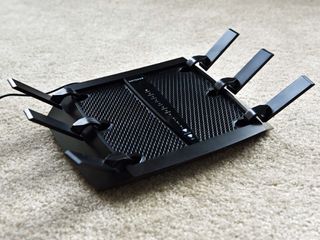
Got yourself a Netgear router? Here are some quick troubleshooting tips.
When you purchase through links on our site, we may earn an affiliate commission. Here’s how it works.

If you're using a Netgear router, then first of all, you made a good choice. While the apps you use to interact with it might not be the greatest feat of design, when it comes to performance you're being well looked after.
But, there are also some common issues you may want to address but aren't sure where to start. Here's some quick troubleshooting tips.
For all troubleshooting, Netgear uses the www.routerlogin.net web app. So you'll need to point a web browser there while connected to the network your router is broadcasting.
The default username and password should be admin to log in. If not, check the documentation that came with your router, or see if it's printed on a label somewhere on the hardware itself.
By default your network name will be something relating to the router like "NETGEAR84-5G" and the password will be completely random and printed on a label somewhere on the router. It's reasonable you want to change these.
Once logged in to the web app you'll find both of these options under wireless. Change them to something more memorable and unique, remembering to click apply before you leave.
The video above uses the BT Smart Hub from the UK as an example, but the basic principle is the same whichever ISP supplied Wi-Fi router you're using.
All the latest news, reviews, and guides for Windows and Xbox diehards.
By submitting your information you agree to the Terms & Conditions and Privacy Policy and are aged 16 or over.
You can just plug your Netgear into the ISP router and it'll start working straight away. But, two different Wi-Fi networks running in the same home can interfere, so for the best performance, you need to turn the ISP supplied one off.
Exact steps will vary, but you'll need to login to the web app of your ISP router using the details provided either in the manual or usually on a label somewhere on the router. You need to locate the setting to either put it in modem only mode or to just turn off its wireless capabilities.
Just like your PC or your phone, your router will occasionally need updating. The easiest way to do it is by logging in to the web app as detailed above. If there's a new firmware, you'll have a message towards the top of the window telling you so.
You'll find the option to update in the advanced tab in the app and under the administration section. The update will be displayed with a one-click to download and install the latest firmware to keep your router running at its best.
This one is more difficult to solve, as it might not be just down to the router. The size of the house will be one contributing factor, as will the positioning of the router. If you can't move the router to a more central location, there are some things you can do.
You could try changing the channel that your Wi-Fi signal is using. If there are other networks nearby using the same channel, it could get congested and as such your speeds may suffer. Login to the web app as above in step 2. In the wireless settings this time you're looking for channel. Pick a different one to the default and see if that helps.
One easy trick is to use the 5GHz connection if your router supports it. A lot of modern routers are dual or tri-band, offering 2.4GHz and 5GHz connections. Typically, 2.4GHz is for distance, 5GHz is for performance. On Netgear routers, you'll see the 5GHz connection as a separate Wi-Fi network in Windows. By default, it'll have 5G at the end of the SSID.
Another thing to try is enabling Netgear's Dynamic QoS (Quality of Service) feature that is supported on some routers. This will help to intelligently prioritize bandwidth to make sure that the most important and demanding tasks, like streaming video and gaming, for example, are getting the share of the bandwidth they need. When you log in to your router's web app you'll find it under the basic menu in the sidebar.
Like everything you can enable this in the web app, but an easier solution is to download the Netgear Genie app for your smartphone. It offers basic access to a number of your router's features, including setting up and managing parental controls.
Grab it for your phone from the links below.
If you're a long-term Netgear router user with your own troubleshooting tips be sure to leave them in the comments below.